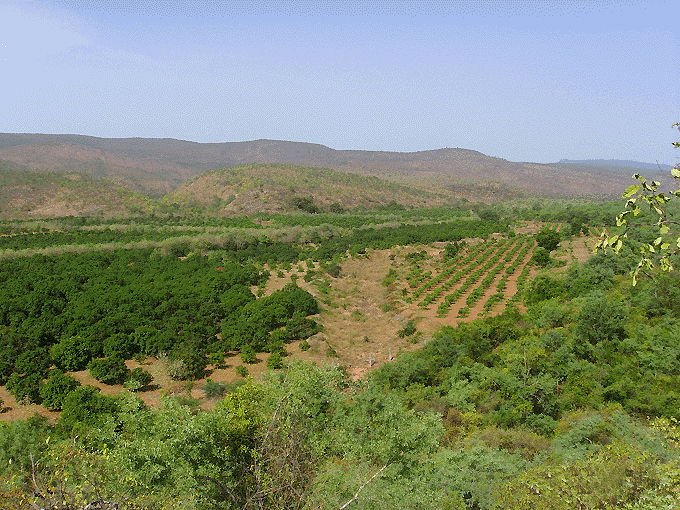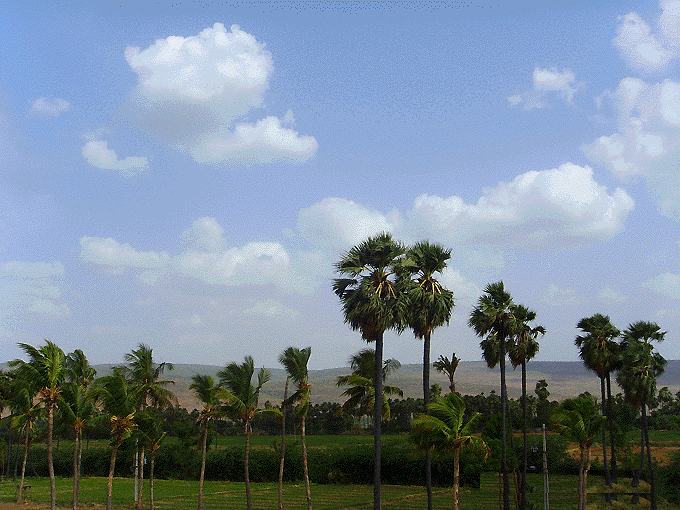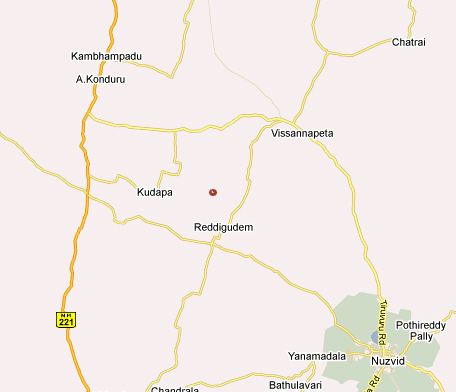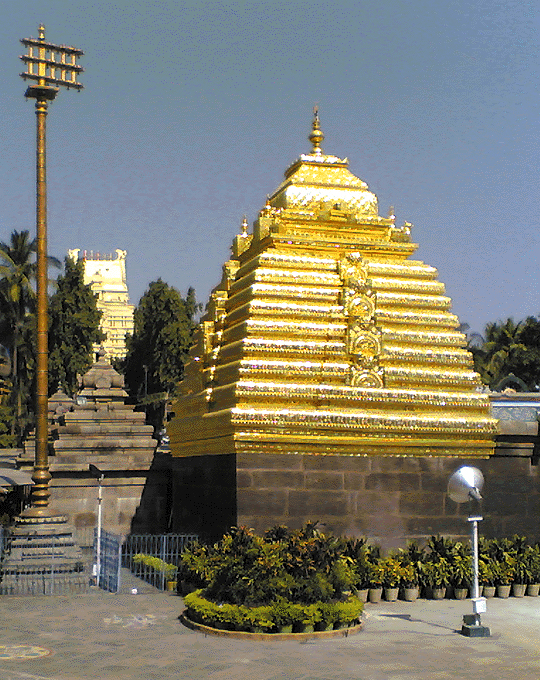
|
|
|
|
BY: SUN STAFF

Countryside around Siddhavata, Andhra Pradesh Mar 06, CANADA (SUN) — A serial exploration of the holy sites visited by Lord Caitanya. Siddhavata
In today's segment, we visit another of the tirtha's that Lord Caitanya Mahaprabhu traveled to on more than one occasion. Distributing His mercy to the holy town of Siddhavata, Lord Caitanya went on from there to Skanda-ksetra and Trimatha, before returning again to Siddhavata. These places are noted in the Summary of Sri Caitanya-caritamrta Madhya Lila 9:
Madhya lila 9 Summary "A summary of the Ninth Chapter is given by Srila Bhaktivinoda Thakura. After leaving Vidyanagara, Sri Caitanya Mahaprabhu visited such places of pilgrimage as Gautami-ganga, Mallikarjuna, Ahovala-nrsimha, Siddhavata, Skanda-ksetra, Trimatha, Vrddhakasi, Bauddha-sthana, Tirupati, Tirumala, Pana-nrsimha, Siva-kanci, Visnu-kanci, Trikala-hasti, Vrddhakola, Siyali-bhairavi, Kaveri-tira and Kumbhakarna-kapala." Later in Madhya Lila we get further details about the location of this tirtha: Madhya 9.17
"Upon seeing the Ahovala-nrsimha Deity, Caitanya Mahaprabhu offered many prayers unto the Lord. He then went to Siddhavata, where He saw the Deity of Ramacandra, the Lord of Sitadevi. PURPORT Madhya 9.18
Upon seeing the Deity of Lord Ramacandra, the descendant of King Raghu, the Lord offered His prayers and obeisances. Then a brahmana invited the Lord to take lunch." Next in Madhya Lila 9 we find a series of slokas which describe Lord Caitanya's pastimes with the brahmana. These verses are well known, being often quoted when discussing the chanting of Krsna's Name, compared with the chanting of Rama's Name. Madhya 9.19 -- "That brahmana constantly chanted the holy name of Ramacandra. Indeed, but for chanting Lord Ramacandra's holy name, that brahmana did not speak a word. Madhya 9.20 -- That day, Lord Caitanya remained there and accepted prasadam at his house. After bestowing mercy upon him in this way, the Lord proceeded ahead." Madhya 9.21 -- At the holy place known as Skanda-ksetra, Lord Sri Caitanya Mahaprabhu visited the temple of Skanda. From there He went to Trimatha, where He saw the Visnu Deity Trivikrama. Madhya 9.22 -- After visiting the temple of Trivikrama, the Lord returned to Siddhavata, where He again visited the house of the brahmana, who was now constantly chanting the Hare Krsna maha-mantra."

Kadapa Village In Madhya 9.23 to 9.38 we get a detailed narrative of the conversation between Mahaprabhu and the brahmana, regarding why he had taken up the chanting of Krsna's Name, rather than Rama's: Madhya 9.23 – "After finishing His lunch there, Sri Caitanya Mahaprabhu asked the brahmana, "My dear friend, kindly tell Me what your position is now. Madhya 9.24 -- Formerly you were constantly chanting the holy name of Lord Rama. Why are you now constantly chanting the holy name of Krsna?" Madhya 9.25 -- The brahmana replied, "This is all due to Your influence, Sir. After seeing You, I have lost my lifelong practice. Madhya 9.26 -- "From my childhood I have been chanting the holy name of Lord Ramacandra, but upon seeing You I chanted the holy name of Lord Krsna just once. Madhya 9.27 -- "Since then, the holy name of Krsna has been tightly fixed upon my tongue. Indeed, since I have been chanting the holy name of Krsna, the holy name of Lord Ramacandra has gone far away. Madhya 9.28 -- "From my childhood I have been collecting the glories of the holy name from revealed scriptures. Madhya 9.29 -- "'The Supreme Absolute Truth is called Rama because the transcendentalists take pleasure in the unlimited true pleasure of spiritual existence.' Madhya 9.30 -- "'The word "krs" is the attractive feature of the Lord's existence, and "na" means spiritual pleasure. When the verb "krs" is added to the affix "na," it becomes "Krsna," which indicates the Absolute Truth.' Madhya 9.31 -- "As far as the holy names of Rama and Krsna are concerned, they are on an equal level, but for further advancement we receive some specific information from the revealed scriptures. Madhya 9.32 -- "[Lord Siva addressed his wife, Durga:] 'O Varanana, 'I chant the holy name of Rama, Rama, Rama and thus enjoy this beautiful sound. This holy name of Ramacandra is equal to one thousand holy names of Lord Visnu.' Madhya 9.33 -- "'The pious results derived from chanting the thousand holy names of Visnu three times can be attained by only one utterance of the holy name of Krsna.' PURPORT Madhya 9.34 -- "According to this statement of the sastras, the glories of the holy name of Krsna are unlimited. Still I could not chant His holy name. Please hear the reason for this. Madhya 9.35 -- "My worshipable Lord has been Lord Ramacandra, and by chanting His holy name I received happiness. Because I received such happiness, I chanted the holy name of Lord Rama day and night. Madhya 9.36 -- "By Your appearance, Lord Krsna's holy name also appeared, and at that time the glories of Krsna's name awoke in my heart. Madhya 9.37 -- "Sir, You are that Lord Krsna Himself. This is my conclusion." Saying this, the brahmana fell down at the lotus feet of Sri Caitanya Mahaprabhu. Madhya 9.38 --After showing mercy to the brahmana, Lord Sri Caitanya Mahaprabhu left the next day and arrived at Vrddhakasi, where He visited the temple of Lord Siva. PURPORT
The story comes to a close with Lord Caitanya finally departing Siddhavata, and going to Vrddhakasi (Vrddhacalam), which was mentioned in yesterday's segment as being different than the tirtha of Vrddhakola that the Lord also visited. Siddhavata Tirtha In Madhya 9.17 we read that before coming to Siddhavata, Lord Caitanya had visited the Deity of Ahovala-nrsimha, Who resides at Ahovilam in Andhra Pradesh. Although Siddhavata (Sidhauta) is not found on modern maps, the village of Kudapa is still listed, as we see on the map below:

Kudapa and region of Siddhavata, Andhra Pradesh Located about 70 kilometers north of the City of Vijayawada, Kudapa is a village in the Krishna district. In his purport to Madhya 9.17, Srila Prabhupada tells us that Siddhavata (Sidhauta) is ten miles east of Kudapa. The distance between Kudapa and Reddigudem is about 12 miles (19 kilometers), which puts Siddhavata somewhere near the red dot, depending on how directly east it is from Kudapa. Kudapa itself has a prominent hill at the center of the village. Devi Saraswati's temple is on a hill, and nearby are temples of Sri Venkateshwara and Shiva. We do not find mention of an existing temple of Lord Rama's there, unfortunately, Siddhavata (Siddha vata, 'vata' referring to the Banyana tree) is also described as being located in Kadapa (Kudapa) district. Siddhavata is considered to be one of the four main dwaras, or gateways of Srisailam:

Srisailam Srisailam, located in the Kurnool district of Andhra Pradesh, in the deep forests surrounding the Nallamala hills, is known as a Siddhi kshetra, having Jyotirlinga and Shakti peetha. According to ancient tradition, it is considered to be one of the main reference points used in locating any place in the world. From the Sankalpa mantram:
The location of Siddhavata and a historical record of how it got its name is mentioned in the manuscript Dharmamrita, a Jain work by Nayasenacharya (1125 A. D.). Dharmamrita contains stories of the Ikshvakus of Andhra Desa, and it mentions several of the tirthas Lord Caitanya visited in that region. Dharmamrita describes the Ikshvaku king Yasodhara, who ruled the region of Anga, with Champapura as his capital. As his death neared, he wanted his three sons to take over ruling the kingdom, but they instead wished to live as sages. The second son, Sridharacarya, also known as Akalanka, was performing penance on a hilltop in the area of Kudapa, but gave it up when tricked out of his meditations by his father's ministers. He was taken back to the capital city, and accepted the reins of power from his ailing father. Taking up married life, Sridharacarya eventually had a son, and was able to turn over rule of the kingdom to him. He then returned to the place of his earlier penance, known as Rishinivasa Parvata (Sri Parvata), and again took up spiritual life. Because Sridharacarya had gotten purification under the great Banyan tree, the place became known as Siddha Vata. A nearby spot with an Arjuna tree became known as Mallikarjuna, which is also near to Vriddhagiri, where Sridhara was coaxed to come down off the hill and leave his meditation. We find mention of both these places in Madhya Lila.
| |